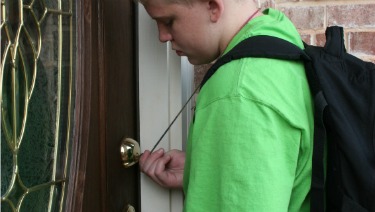
Establishing a safe at home routine for kids
Featured in the Daily Sun:
The kids are back are in school and making the transition from summer break to full-time students. While learning and mastering the “three Rs” in school is important, it is also vital for kids to be educated in the basics of home safety and how to respond in case of an emergency. This is especially important when tweens and teens are home alone for the first time after school.
According to some estimates, almost 60 percent of homeowners will experience an emergency or accident ranging from severe weather, house or stove fire, gas leak to something less hazardous, such as locking oneself out of the house. The good news is that by making some basic preparations in advance, you can lessen the impact of home emergencies – or maybe prevent some altogether.
1. Knowing your children
Recent surveys report that one in three adolescents will come home from school to an empty house. Before deciding to leave your kids alone at home for the first time, parents should determine if they are ready. According to the American Academy of Pediatrics, the general age when you can leave children at home is 11-12 years old.
Once it’s determined that your child will stay home alone, provide them with some safety coaching. Make sure they are prepared for an emergency or accident, be it a power outage, stove-top fire, minor injury (like a bloody nose) or even knowing where the shut off valve is for over-flowing sinks or toilets.
Be sure your child knows who to contact in case of an emergency and make sure your neighbors know your child will be home alone after school.
The American Academy of Pediatrics provides a host of great resources at www.healthychildren.orgincluding a checklist to help determine if your child is ready to stay home after school alone.
2. Preparation
To head off possible hazards, your safety checklist should include regular cleaning and maintenance of dryer vents, air filters, chimneys, wood and pellet stove pipes. This leads to improved efficiency and will help protect your house from fire and carbon monoxide poisoning. Check and replace batteries in smoke detectors.
Other preparation tips:
• Make sure you have key information – medical and insurance contacts/phone numbers in one place.
• It’s important to have a weather emergency kit on hand. Key items should include: a portable radio with batteries, flashlights and batteries, a three-day supply of food and water and first aid kit.
For resources and tips, please visit: www.ready.gov/build-a-kit
3. Have an escape plan
Despite the best planning, emergencies happen. That’s why every household should have an evacuation plan in place. This is important for everyone, but particularly if there are youngsters or seniors living in the home. Determine how you’ll get out, where you’ll meet and how you’ll communicate with one another. Establish at least two escape routes from your house.
If you have a senior or someone with limited mobility living in the home, inform local police and fire departments.
4. Practice makes perfect
Like fire drills at school or work, you should have a fire drill at home. Make sure young children know what a smoke/ C O2 alarm sounds like and show them where the alarms are. Having a drill is a good way to gauge your preparedness and determine if exits are easy to find and free of obstacles.
Every home should have a functional fire extinguisher in a location familiar and accessible to all occupants. A fire extinguisher is only effective if the user is informed on its proper use. Please follow the manufacturer’s instructions on placement and proper use. Should you have questions or concerns, your local fire department is a great resource. They also may offer fire extinguisher training classes. The Partnership for Public Health is pleased to work with the Lakes Region Community Emergency Response Teams (LR-CERT) which also provide fire extinguisher training. Please contact me at jbeland@pphnh.orgat (603) 528-2145 for more information on LR-CERT.
Additional information on fire extinguisher training can also be found at www.usfa.fema.gov/prevention/outreach/extingishers.html.
The Partnership for Public Health is proud to partner with town officials, health officers, emergency management directors, fire/rescue workers, police, schools and others to: limit illness and death, preserve continuity of government/business, minimize social disruption and minimize economic loss. For details, please visit our website at www.pphnh.org.
John Beland is the Partnership for Public Health’s Emergency Preparedness and Response Manager. He has more than 30 years of expertise and leadership in the public health and safety environment.
